Old Fashioned Wet Well Swimming Pools
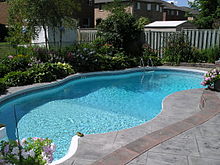

A swimming pool, swimming bath, wading pool, paddling pool, or simply pool, is a structure designed to hold h2o to enable swimming or other leisure activities. Pools can be built into the ground (in-basis pools) or built above ground (as a freestanding structure or as part of a building or other larger structure), and may be found every bit a feature aboard ocean-liners and prowl ships. In-footing pools are nigh unremarkably constructed from materials such equally concrete, natural stone, metal, plastic, or fiberglass, and tin can be of a custom size and shape or built to a standardized size, the largest of which is the Olympic-size pond pool.
Many wellness clubs, fitness centers, and private clubs accept pools used generally for exercise or recreation. It is common for municipalities of every size to provide pools for public use. Many of these municipal pools are outdoor pools but indoor pools tin can also be found in buildings such as leisure centers. Hotels may have pools available for their guests to apply at their own leisure. Pools as a feature in hotels are more mutual in tourist areas or well-nigh convention centers. Educational facilities such as high schools and universities sometimes have pools for physical education classes, recreational activities, leisure, and competitive athletics such as swimming teams. Hot tubs and spas are pools filled with water that is heated and then used for relaxation or hydrotherapy. Specially designed swimming pools are as well used for diving, water sports, and physical therapy, equally well as for the training of lifeguards and astronauts. Swimming pools most commonly apply chlorinated water or salt water and may be heated or unheated.
History [edit]
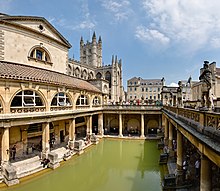
Ancient Roman baths in Bath, England
The "Great Bath" at the site of Mohenjo-Daro in modern-day Pakistan was near likely the commencement swimming puddle, dug during the tertiary millennium BC. This pool is 12 by 7 metres (39 by 23 anxiety), is lined with bricks, and was covered with a tar-based sealant.[1]
Ancient Greeks and Romans built bogus pools for athletic training in the palaestras, for nautical games and for military exercises. Roman emperors had private swimming pools in which fish were also kept, hence 1 of the Latin words for a pool was piscina. The first heated pond pool was built past Gaius Maecenas in his gardens on the Esquiline Loma of Rome, likely onetime between 38 and viii BC.[2] Gaius Maecenas was a wealthy imperial advisor to Augustus and considered one of the first patrons of arts.[3]
Ancient Sinhalese congenital pairs of pools chosen "Kuttam Pokuna" in the kingdom of Anuradhapura, Sri Lanka in the 4th century BC. They were decorated with flights of steps, punkalas or pots of abundance, and scroll design.[4]
19th century [edit]
Swimming pools became pop in Britain in the mid-19th century. As early as 1837, six indoor pools with diving boards existed in London, England.[five] The Maidstone Swimming Club in Maidstone, Kent is believed to be the oldest surviving pond lodge in Britain. Information technology was formed in 1844, in response to concerns over drownings in the River Medway, specially since would-be rescuers would often drown because they themselves could non swim to rubber. The club used to swim in the River Medway, and would hold races, diving competitions and water polo matches. The South East Gazette July 1844 reported an aquatic breakfast party: coffee and biscuits were served on a floating raft in the river. The coffee was kept hot over a burn; society members had to tread water and drinkable coffee at the same time. The last swimmers managed to overturn the raft, to the amusement of 150 spectators.[6]
The Amateur Pond Association was founded in 1869 in England,[ citation needed ] and the Oxford Swimming Club in 1909.[7] The presence of indoor baths in the cobbled area of Merton Street might have persuaded the less hardy of the aquatic brigade to join. So, bathers gradually became swimmers, and bathing pools became pond pools.[ citation needed ] In 1939, Oxford created its first major public indoor pool at Temple Cowley.
The modern Olympic Games started in 1896 and included swimming races, afterwards which the popularity of pond pools began to spread. In the US, the Racquet Club of Philadelphia clubhouse (1907) boasts one of the globe's get-go modern above-ground swimming pools. The first pond pool to go to body of water on an ocean liner was installed on the White Star Line'due south Adriatic in 1906.[8] The oldest known public swimming pool in the U.S., Underwood Puddle, is located in Belmont, Massachusetts.[9]

Interest in competitive swimming grew post-obit World War I. Standards improved and training became essential. Home pond pools became pop in the U.s. later on World State of war II and the publicity given to swimming sports past Hollywood films such as Esther Williams' Million Dollar Mermaid made a home pool a desirable condition symbol. More 50 years subsequently, the dwelling or residential swimming pool is a mutual sight. Some small nations enjoy a thriving swimming pool manufacture (due east.g., New Zealand popular. iv,116,900 – holds the record in pools per capita with 65,000 dwelling swimming pools and 125,000 spa pools).[eleven]
A two-storey, white physical swimming pool edifice composed of horizontal cubic volumes built in 1959 at the Royal Roads Military College is on the Registry of Historic Places of Canada.[12]
Earth records [edit]

Moskva Pool, at one time the largest swimming puddle in the world (1980)
According to the Guinness World Records, the largest swimming pool in the world is San Alfonso del Mar Seawater pool in Algarrobo, Chile. Information technology is i,013 m (3,323 ft) long and has an area of 8 ha (20 acres). At its deepest, it is three.5 k (eleven ft) deep.[13] Information technology was completed in December 2006.[14]
The largest indoor wave pool in the world is at DreamWorks H2o Park within the American Dream shopping and entertainment complex at the Meadowlands Sports Circuitous in East Rutherford, New Bailiwick of jersey, United States, and the largest indoor pool in North America is at the Neutral Buoyancy Lab in the Sonny Carter Training Facility at NASA JSC in Houston.[xv] [16]
In 2021, Deep Dive Dubai, located in Dubai, UAE, was certified by the Guinness Book of World Records as the globe's deepest swimming pool.[17] [18] The Y-forty pond pool at the Hotel Terme Millepini in Padua, Italy, previously held the record, 42.15 m (138.iii ft), from 2014 until 2021.[19]
The Fleishhacker Pool in San Francisco was the largest heated outdoor swimming pool in the Usa. Opened on 23 Apr 1925, it measured 1,000 by 150 ft (300 by l m) and was so big that the lifeguards required kayaks for patrol. It was closed in 1971 due to low patronage.[20]
In Europe, the largest swimming pool opened in 1934 in Elbląg (Poland), providing a water surface area of 33,500 foursquare metres (361,000 sq ft).[21]
One of the largest swimming pools ever built was reputedly created in Moscow after the Palace of Soviets remained uncompleted. The foundations of the palace were converted into the Moskva Pool open up-air pond pool after the process of de-Stalinisation.[22] However, after the autumn of communism, Christ the Saviour Cathedral was re-built on the site betwixt 1995 and 2000; the cathedral had originally been located there.[ citation needed ]
The highest swimming puddle is believed to be in Yangbajain (Tibet, China). This resort is located at 4200 m AMSL and has two indoor swimming pools and 1 outdoor pond pool, all filled with h2o from hot springs.[23]
Dimensions [edit]
- Encounter: Competition pools (below)

Cairns Lagoon, a public swimming pool in Australia
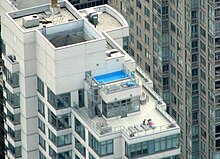
Length: Almost pools in the globe are measured in metres, only in the United States pools are often measured in feet and yards. In the Uk most pools are calibrated in metres, but older pools measured in yards yet exist. In the United states, pools tend to either be 25 yards (SCY-short course yards), 25 metres (SCM-brusque course metres) or 50 metres (long course). United states high schools and the NCAA conduct short course (25 yards) competition. In that location are also many pools 33+ 1⁄iii 1000 long, so that three lengths = 100 m. This puddle dimension is commonly used to accommodate water polo.[ citation needed ]
U.s. Pond (USA-S) swims in both metric and non-metric pools. Nonetheless, the international standard is metres, and world records are but recognized when swum in 50 m pools (or 25 m for short form) but 25-grand pools are very mutual in the US. In general, the shorter the puddle, the faster the time for the aforementioned distance, since the swimmer gains speed from pushing off the wall after each turn at the stop of the pool.
Width: Almost European pools are between ten thou and 50 m wide.[ citation needed ]
Depth: The depth of a swimming pool depends on the purpose of the pool, and whether it is open to the public or strictly for private use. If information technology is a private casual, relaxing puddle, it may go from i.0 to two.0 m (3.3 to 6.6 ft) deep. If it is a public pool designed for diving, it may slope from 3.0 to 5.v thousand (x to 18 ft) in the deep end. A children's play pool may be from 0.3 to 1.two m (1 to 4 ft) deep. Well-nigh public pools have differing depths to conform different swimmer requirements. In many jurisdictions, it is a requirement to evidence the water depth with clearly marked depths affixed to the pool walls.[ citation needed ]
Types [edit]
Pools can be either indoors or outdoors. They can be of any size and shape, and inground or above ground. Most pools are permanent fixtures, while others are temporary, collapsible structures.
Private pools [edit]

An to a higher place-ground swimming pool
Private pools are usually smaller than public pools, on average 3.7 g × vii.3 m (12 ft × 24 ft) to half-dozen.ane m × 12.two grand (20 ft × 40 ft) whereas public pools usually start at 24 thou (80 ft).[ citation needed ] Abode pools can be permanently built-in, or be assembled higher up ground and disassembled after summer. Privately endemic outdoor pools in backyards or gardens started to proliferate in the 1950s in regions with warm summer climates, peculiarly in the United States with desegregation.[24]
Structure methods for private pools vary greatly. The master types of in-ground pools are gunite shotcrete, concrete, vinyl-lined, and one-slice fiberglass shells.
Many countries now accept strict pool fencing requirements for individual pond pools, which require pool areas to be isolated so that unauthorized children younger than six years cannot enter. Many countries require a similar level of protection for the children residing in or visiting the house, although many puddle owners prefer the visual aspect of the pool in close proximity to their living areas, and volition not provide this level of protection. There is no consensus betwixt states or countries on the requirements to argue private swimming pools, and in many places they are not required at all, particularly in rural settings.[25]
Children'due south pools [edit]
Inexpensive temporary polyvinyl chloride pools tin be bought in supermarkets and taken downwards afterwards summer. They are used mostly outdoors in yards, are typically shallow, and frequently their sides are inflated with air to stay rigid. When finished, the water and air can exist let out and this type of pool tin be folded up for convenient storage. They are regarded in the pond pool industry as "splasher" pools intended for cooling off and amusing toddlers and children, non for swimming, hence the alternate name of "kiddie" pools.[ citation needed ]
Toys are available for children and other people to play with in pool water. They are ofttimes blown up with air and so they are soft but still reasonably rugged, and can float in water.
-
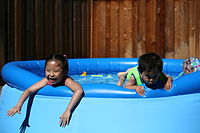
Children playing in an inflatable pool
Public pools [edit]

A spa at Hotel Fra Mare in Estonia
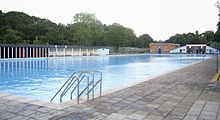
Public pools are often part of a larger leisure eye or recreational complex. These centres frequently have more than one puddle, such as an indoor heated puddle, an outdoor (chlorinated, saltwater or ozonated) puddle which may exist heated or unheated, a shallower children's pool, and a paddling pool for toddlers and infants. In that location may as well be a sauna and one or more hot tubs or spa pools ("jacuzzis").
Many upscale hotels and holiday resorts have a swimming pool for apply by their guests. If a pool is in a split up edifice, the building may be called a natatorium. The building may sometimes besides accept facilities for related activities, such as a diving tank. Larger pools sometimes take a diving lath affixed at one edge above the water.
Many public pond pools are rectangles 25 m or l m long, but they can be whatsoever size and shape. At that place are also elaborate pools with bogus waterfalls, fountains, splash pads, moving ridge machines, varying depths of water, bridges, and island bars.

Children's pool at the SaiGaau Pond Puddle
Some swimming facilities have lockers for wear and other belongings. The lockers can require a money to be inserted in a slot, either as deposit or payment. There are usually showers – sometimes mandatory – before and/or afterwards swimming. At that place are often too lifeguards to ensure the safety of users.
Wading or paddling pools are shallow bodies of water intended for utilize by small children, usually in parks. Concrete wading pools come up in many shapes, traditionally rectangle, square or circumvolve. Some are filled and tuckered daily due to lack of a filter system. Staff chlorinate the water to ensure health and safety standards.[ citation needed ]
Contest pools [edit]
- See: #Dimensions (in a higher place) and Pond (sport)#Contest pools


A simplified diagram of the FINA long course swimming pool standard, used at the Earth Championships and Summer Olympics
The Fédération Internationale de la Natation (FINA, International Swimming Federation) sets standards for competition pools: 25 or 50 one thousand (82 or 164 ft) long and at to the lowest degree 1.35 m (4.4 ft) deep. Competition pools are generally indoors and heated to enable their use all twelvemonth round, and to more hands comply with the regulations regarding temperature, lighting, and automated officiating equipment.
An Olympic-size swimming pool (first used at the 1924 Olympics) is a pool that meets FINA's additional standards for the Olympic Games and for world championship events. Information technology must exist 50 by 25 m (164 by 82 ft) wide, divided into viii lanes of 2.5 m (8.two ft) each, plus 2 areas of ii.five 1000 (8.2 ft) at each side of the pool. Depth must be at least 2 thou (6.6 ft).[26]
The water must be kept at 25–28 °C (77–82 °F) and the lighting level at greater than 1500 lux. In that location are besides regulations for colour of lane rope, positioning of backstroke flags (five metres from each wall), and so on.[26] Pools claimed to be "Olympic pools" do not always meet these regulations, as FINA cannot constabulary utilise of the term. Touchpads are mounted on both walls for long class meets and each end for short form.
A puddle may be referred to as fast or tiresome, depending on its concrete layout.[27] Some design considerations permit the reduction of swimming resistance making the pool faster: namely, proper puddle depth, emptying of currents, increased lane width, energy absorbing racing lane lines and gutters, and the utilize of other innovative hydraulic, acoustic and illumination designs.

Pool tiles' longer rectangular edges may exist parallel to the pool's long sides to help swimmers orient themselves.
Practice pools [edit]
In the final two decades, a new manner of pool has gained popularity. These consist of a small vessel (unremarkably virtually ii.v × five thousand) in which the swimmer swims in place, either against the push of an artificially generated water current or against the pull of restraining devices. These pools have several names, such equally swim spas, swimming machines, or swim systems. They are all examples of different modes of resistance swimming.
Hot tubs and spa pools [edit]

Hot tubs and spa pools are common heated pools used for relaxation and sometimes for therapy. Commercial spas are common in the swimming pool area or sauna area of a health club or fitness eye, in men'due south clubs, women's clubs, motels and exclusive five-star hotel suites. Spa clubs may have very large pools, some segmented into increasing temperatures. In Japan, men'due south clubs with many spas of unlike size and temperature are common. Commercial spas are more often than not fabricated of concrete, with a mosaic tiled interior. More recently with the innovation of the pre-form composite method where mosaic tiles are bonded to the trounce this enables commercial spas to exist completely factory manufactured to specification and delivered in one piece. Hot tubs are typically fabricated somewhat like a wine butt with directly sides, from wood such as Californian redwood held in place past metal hoops. Immersion of the head is not recommended in spas or hot tubs due to a potential risk of underwater entrapment from the pump suction forces. However, commercial installations in many countries must comply with various safety standards which reduce this risk considerably.

A male child relaxing in a hot tub
Dwelling spas are a worldwide retail item in western countries since the 1980s, and are sold in dedicated spa stores, pool shops, department stores, the Internet, and itemize sales books. They are near always fabricated from heat-extruded acrylic sheet Perspex, oftentimes colored in marble look-akin patterns. They rarely exceed half-dozen chiliadii (65 sq ft) and are typically ane m (three ft 3 in) deep, restricted by the availability of the raw sail sizes (typically manufactured in Nippon). There is often a mid-depth seating or lounging system, and contoured lounger style reclining seats are common. Upmarket spas include various jet nozzles (massage, pulsating, etc.), a drinks tray, lights, LCD flat-screen TV sets and other features that brand the puddle a recreation center. Due to their family-oriented nature, home spas are ordinarily operated from 36 to 39 °C (97 to 102 °F). Many pools are incorporated in a redwood or simulated wood environs, and are termed "portable" as they may be placed on a patio rather than sunken into a permanent location. Some portable spas are shallow and narrow enough to fit sideways through a standard door and exist used within a room. Low power electrical immersion heaters are mutual with abode spas.
Whirlpool tubs first became popular in the U.S. during the 1960s and 1970s. A spa is also called a "jacuzzi" at that place, equally the give-and-take became a generic after-plumbing component manufacturer; Jacuzzi introduced the "spa whirlpool" in 1968. Air bubbles may be introduced into the nozzles via an air-bleed venturi pump that combines cooler air with the incoming heated water to cool the pool if the temperature rises uncomfortably high. Some spas have a constant stream of bubbles fed via the seating area of the pool, or a footwell area. This is more common as a temperature control device where the heated water comes from a natural (uncontrolled heat) geothermal source, rather than artificially heated. Water temperature is usually very warm to hot – 38 to 42 °C (100 to 108 °F) – so bathers unremarkably stay in for only 20 to thirty minutes. Bromine or mineral sanitizers are often recommended as sanitizers for spas because chlorine dissipates at a high temperature, thereby heightening its potent chemic scent. Ozone is an effective bactericide and is commonly included in the circulation arrangement with cartridge filtration, only not with sand media filtration due to clogging problems with turbid body fats.
Bounding main pools [edit]

An ocean pool at Coogee in Sydney, Australia
In the early on 20th century, especially in Australia, bounding main pools were built, typically on headlands by enclosing role of the stone shelf, with water circulated through the pools by flooding from tidal tanks or by regular flooding over the side of the pools at high tide. This continued a pre-European tradition of bathing in rockpools with many of the electric current sites being expanded from sites used past Aboriginal Australians or early European settlers. Bathing in these pools provided security confronting both crude surf and ocean life. There were often separate pools for women and men, or the pool was open to the sexes at different times with a pause for bathers to climb in without fear of observation by the other sex.[28] These were the forerunners of modern "Olympic" pools. A variation was the later evolution of body of water- or harbour-side pools that circulated bounding main water using pumps. A pool of this blazon was the training footing for Australian Olympian Dawn Fraser.
At that place are currently about 100 sea baths in New South Wales, which can range from small pools roughly 25 metres long and "Olympic Sized" (50m) to the very large, such every bit the 50 × 100 m baths in Newcastle. While most are free, a number accuse fees, such as the Bondi Icebergs Gild pool at Bondi Beach. Despite the development of chlorinated and heated pools, sea baths remain a popular form of recreation in New South Wales.
A semi-natural sea puddle exists on the fundamental declension of New South Wales; it is called The Bogey Hole.
Infinity pools [edit]


The Marina Bay Sands SkyPark Infinity Pool in Singapore, viewed from the poolside (left) and about the border (right)
An infinity puddle (also named negative edge or vanishing border pool) is a swimming pool which produces a visual event of h2o extending to the horizon, vanishing, or extending to "infinity". Often, the h2o appears to fall into an ocean, lake, bay, or other similar body of water. The illusion is most effective whenever at that place is a significant change in elevation, though having a natural trunk of water on the horizon is not a limiting cistron.[ citation needed ]
Natural pools and ponds [edit]
Natural pools were adult in key and western Europe in the early and mid-1980s by designers and landscape architects with ecology concerns. They accept recently been growing in popularity equally an alternative to traditional swimming pools.[29] Natural pools are synthetic bodies of water in which no chemicals or devices that disinfect or sterilize water are used, and all the cleaning of the puddle is accomplished purely with the movement of the water through biological filters and plants rooted hydroponically in the system. In essence, natural pools seek to recreate swimming holes and swimmable lakes, the environment where people feel safe swimming in a non-polluted, healthy, and ecologically balanced body of h2o.
H2o in natural pools has many desirable characteristics. For example, red eyes, dried-out skin and pilus, and bleached bathing suits associated with overly chlorinated water are naturally absent in natural pools.[ citation needed ] Natural pools, by requiring a water garden to be a part of the organisation, offering different aesthetic options and can support amphibious wildlife such as snails, frogs, and salamanders, and fifty-fifty small fish if desired.
Zero-entry swimming pools [edit]

A nothing-entry swimming puddle, also called a embankment entry swimming pool, has an border or entry that gradually slopes from the deck into the h2o, becoming deeper with each step, in the manner of a natural embankment. Every bit there are no stairs or ladders to navigate, this type of entry assists older people, young children and people with accessibility bug (due east.g., people with a physical inability) where gradual entry is useful.
Indoor pools [edit]
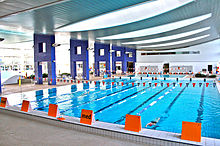
Indoor pools are located inside, nether a roof and insulated by at least three walls. Congenital for the purpose of year-round swimming or training, they are constitute in all climate types. Since the pool room is insulated, it is less likely the heat will escape; making information technology less expensive to heat than an outdoor puddle where the heat will escape.[xxx] Architecturally, the indoor pool may look like the residue of the firm, but in terms of engineering, variables such as heating and ventilation are required to ensure comfortable humidity levels. In addition to drainage and automatic pool covers, there are a number of ways to remove humidity in the air that is present with any wet indoor environs. Efficient dehumidification in the indoor pool environment prevents structural damage, lowers energy costs for cooling or heating in addition to improving the room's climate to make it a comfortable pond surroundings.
Other uses [edit]


An astronaut prepares to descend into a pond puddle equally office of a grooming exercise.
Pond pools are besides used for events such as synchronized swimming, water polo, canoe polo and underwater sports such as underwater hockey, underwater rugby, finswimming and sport diving every bit well as for instruction diving, lifesaving and scuba diving techniques. They accept also been used for specialist tasks such as didactics h2o-ditching survival techniques for aircraft and submarine crews and astronaut grooming. Round-cornered, irregular swimming pools, such as the Nude Bowl, were drained of water and used for vertical skateboarding.
Sanitation [edit]

Levels of bacteria and viruses in swimming pool water must exist kept depression to prevent the spread of diseases and pathogens. Bacteria, algae and insect larvae can enter the pool if h2o is not properly sanitized. Pumps, mechanical sand filters, and disinfectants are often used to sanitise the water.
Chemical disinfectants, such as chlorine (usually as a hypochlorite salt, such as calcium hypochlorite) and bromine, are unremarkably used to kill pathogens. If not properly maintained, chemical sanitation tin produce loftier levels of disinfection byproducts. Sanitized swimming pool water can theoretically appear green if a certain amount of fe salts or copper chloride are nowadays in the water.[31]
Acesulfame potassium has been used to estimate how much urine is discharged by swimmers into a pool.[32] In a Canadian study it was estimated that swimmers had released 75 litres of urine into a big puddle that had well-nigh 830,000 litres of water and was a third of the size of an olympic pool. Hot tubs were found to take higher readings of the marker. While urine itself is sterile, its degradation products may lead to asthma.[32]
Covers [edit]
Pond puddle heating costs tin can be significantly reduced by using a pool encompass. Use of a pool cover also tin help reduce the corporeality of chemicals (chlorine, etc.) required past the pool. Outdoor pools gain oestrus from the sun, arresting 75–85% of the solar free energy hit the pool surface. Though a cover decreases the total corporeality of solar estrus absorbed by the pool, the cover eliminates heat loss due to evaporation and reduces heat loss at night through its insulating properties. Most pond pool heat loss is through evaporation.[33]
The heating effectiveness of a cover depends on blazon. A transparent bubble cover is the about effective, as it allows the largest amount of solar flux into the pool itself. Thermal chimera covers are lightweight UV-stabilized floating covers designed to minimize rut loss on heated swimming pools. Typically they are simply fitted in jump and fall (autumn) when the temperature departure between puddle water and air temperature is greatest. When used consistently they can raise boilerplate puddle temperatures of an outdoor puddle past around xviii °Fahrenheit (xi °Celsius) when combined with a well sized solar pool heating system, or most 11° Fahrenheit (6 °Celsius) without a solar heater but with full sun exposure.[34] [ better source needed ] Bubble covers are typically applied and removed by being rolled upwardly on a device fitted to one side of the pool (see analogy). Covers fall apart later on four or five years due to sun exposure, overheating in the sun while off the pool, and chlorine attacking the plastic. Bubble covers should be removed during superchlorination.
A vinyl cover absorbs more sunlight straight, allowing temperature to rise faster, but ultimately prevents the pool from reaching as high a temperature every bit a articulate encompass.[35] Vinyl covers consist of a heavier material and have a longer life expectancy than chimera covers. Insulated vinyl covers are also bachelor with a thin layer of flexible insulation sandwiched betwixt ii layers of vinyl.[35] These covers are mandatory[ commendation needed ] to be fitted to all pools in areas of Australia that take experienced drought since 2006. This is an effort to conserve water, as much h2o evaporates and transpires.
An alternative to a continuous sail of pool covering is multiple floating disks which are deployed and removed disk by disk. They cover nearly of the surface of the puddle and offering evaporation reduction like to continuous covers. Various types are available, for example opaque (for UV resistance and possible reduced algal growth), transparent (for esthetics), heavy and solid (for wind resistance), light and inflatable (for ease of handling).
- Liquid covers
Liquid covers are also an option. They use a microscopically thin layer of liquid (such as cetyl alcohol) that sits on the water surface and reduces evaporation, which is i of the major sources of oestrus loss too as h2o loss. Different other covers, the puddle can exist used while the liquid cover is in place, and the nontoxic material is safe for people likewise as pumping/filtering systems. The liquid must be replenished regularly (monthly or more), and may not be effective in windy areas (since the air current will disperse the thin layer).
- Safety covers
These covers are typically attached all winter, past hooked bungee cords or hooked springs connected to the pool deck, and are usually fabricated in a variety of materials including coated or laminated vinyl or polypropylene mesh. They are custom designed to finish leaf debris from entering the pool but more importantly they also provide condom for animals and pocket-sized children when designed and installed properly. The custom safe embrace was invented in 1957 past Fred Meyer Jr. of Meyco Pool Covers when he found a expressionless animal in his puddle. Today covers are made to run into ASTM safety barrier standards and have kept animals, people and even large vehicles out of the pool. They are not pop in warmer climates, due to the v to ten minutes it takes to fit/remove them, making them inconvenient for repeated awarding and removal.
Pool cover automation [edit]
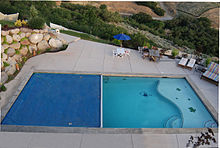
A pool cover tin can exist either manually, semi-automatically, or automatically operated. Transmission covers tin can be folded and stored in an off site location. Pool cover reels tin can as well be used to help manually roll up the pool embrace. The reel, usually on wheels, can be rolled in or out of place.
Semi-automatic covers use a motor-driven reel system. They employ electrical ability to roll and unroll the encompass, but usually crave someone to pull on the embrace when unrolling, or guide the cover onto the reel when rolling up the cover. Semi-automatic covers can exist built into the pool deck surrounding the puddle, or can use reels on carts.
Automatic covers have permanently mounted reels that automatically cover and uncover the pool at the push of a button. They are the most expensive option, only are also the most convenient. These reels can be run from either an external motor requiring a pit to be dug beside the pool or using an internal motor that spins the reel.
Some pool covers fit into tracks along the sides of the puddle. This prevents anything or everyone from getting into the pool. They fifty-fifty support the weight of several people. They tin can be run manually, semi-automatically, or automatically. Rubber covers may be required by inspectors for public pools.[35]
Winterization [edit]
In areas which reach freezing temperature, it is important to close a pool properly. This varies greatly betwixt in-ground and above-ground pools. By taking steps to properly secure the puddle, it lessens the likelihood that the superstructure will be damaged or compromised past freezing water.[36]
Closing vinyl and fibreglass pools [edit]
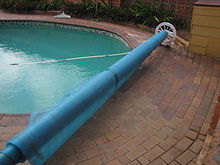
A rolled up Thermal Bubble pool embrace, used to reduce water loss from evaporation and heat loss from the pool
In preparation for freezing temperatures, an in-footing swimming pool's pipes must exist emptied. An above-footing pool should also exist closed, then that ice does not drag downwards the pool wall, collapsing its structure. The plumbing is sealed with air, typically with rubber plugs, to preclude groovy from freezing water. The pool is typically covered to preclude leaves and other debris from falling in. The embrace is attached to the puddle typically using a stretch string, similar to a bungee cord, and hooks fitted into the pool surround. The skimmer is closed off or a floating device is placed into it to prevent it from completely freezing and nifty. Floating objects such every bit life rings or basketballs tin can be placed in the pool to avoid its freezing under the cover. Sand or DE filters must exist backwashed, with the main drain plug removed and all water tuckered out. Drain plugs on the pool filter are removed subsequently the filter has been cleaned. The pool pump motor is taken under encompass. Winter chemicals are added to keep the pool clean. The innovation of a composite construction of fiberglass, with an epoxy coating and porcelain ceramic tiles has led to the pre-form, composite-type with pregnant advantages over older methods; nonetheless, information technology as well has increased sensitivity to metal staining.
In climates where at that place is no take a chance of freezing, endmost down the pool for wintertime is not and then important. Typically, the thermal cover is removed and stored. Winter sunlight can create an algae mess when a cover that has been left on all winter is removed. The pool is correctly pH-balanced and super-chlorinated. One part algaecide for every 50,000 parts of pool h2o should be added, and topped up each month. The pool should be filtered for i to two hours daily to keep the automatic chlorination system agile.[ commendation needed ]
Safety [edit]

Pools pose a risk of drowning, which may be significant for swimmers who are inexperienced, suffer from seizures, or are susceptible to a heart or respiratory condition. Lifeguards are employed at well-nigh pools to execute water rescues and administer start aid as needed in order to reduce this risk.
Diving in shallow areas of a pool may also lead to significant head and neck injuries; diving, specially head-first diving, should be washed in the deepest bespeak of the pool, minimally 2.iv chiliad (vii ft 10 in), only desirably 3.7 yard (12 ft), deeper if the distance betwixt the water and the board is great.
Pools as well present a risk of expiry due to drowning, particularly in young children. In regions where residential pools are common, drowning is a major cause of childhood expiry. As a precaution, many jurisdictions require that residential pools exist enclosed with fencing to restrict unauthorized access. Many products be, such as removable baby fences. The evidence for floating alarms and window/door alarms to reduce the risk of drowning is poor.[37] Some pools are equipped with computer-aided drowning prevention or other forms of electronic safety and security systems.
Suspended ceilings in indoor swimming pools are safety-relevant components. The selection of materials under tension should be washed with care. Especially the option of unsuitable stainless steels can cause problems with stress corrosion dandy.[38]
Clothes code [edit]
In public swimming pools, wearing apparel lawmaking may exist stricter than on public beaches, and in indoor pools stricter than outdoor pools. For example, in countries where women can exist topless on the beach, this is oftentimes not allowed in a swimming pool, and a swimsuit must be worn. For men, wearing ordinary shorts and a T-shirt to get in the water at a embankment may be considered acceptable, but pools usually require real swim suits or other dedicated water wear. Swimming with regular clothes can potentially counterbalance a swimmer down should they need to be rescued. In France and another European countries, board shorts are unremarkably not allowed for "aseptic" reasons. In Nordic countries, in particular Iceland, rules about vesture and hygiene are peculiarly strict.[39] When diving from a high board, swimsuits are sometimes worn doubled up (1 brief inside another) in case the outer arrange tears on affect with the water.
Run across as well [edit]
- Automated pool cleaner
- Bather load
- Lido
- List of water games
- Neutral buoyancy puddle
- Pool argue
- Pool noodle
- Respiratory risks of indoor swimming pools
- Swimming pool service technician
- Uniform Swimming Pool, Spa and Hot Tub Code
- Urine-indicator dye
References [edit]
- ^ "Great Bath, Mohenjo-daro". harappa.com.
- ^ Wiseman, T.P. (twenty September 2016). "Maecenas and the Stage". Papers of the British Schoolhouse at Rome. 84: 131–155. doi:10.1017/S0068246216000040. S2CID 193579486.
- ^ "Gaius Maecenas, or Gaius Cilnius Maecenas (Roman diplomat and patron)". Britannica Online Encyclopedia. Archived from the original on 13 October 2007.
- ^ "Virtual Library: Anuradhapura".
- ^ "Lidos: Links and References". Archived from the original on 23 February 2015. Retrieved 19 Apr 2015.
- ^ "Historical Titbits". Maidstone Swimming Social club. Archived from the original on 25 January 2012. Retrieved 26 October 2011.
- ^ The City of Oxford Pond Club, History
- ^ "TGOL – Adriatic". Archived from the original on eleven June 2015.
- ^ Belmont Historical Social club; et al. (2000). Belmont. Charleston, SC: Arcadia Publishing. p. 8. ISBN978-0738504667 . Retrieved 15 November 2016.
- ^ Yrjönkatu Swimming Hall – My Helsinki
- ^ NZ Demography, 7 March 2006.
- ^ "HistoricPlaces.ca – Recherche". Archived from the original on 24 February 2009.
- ^ Berlin, Jeremy. "Big Dipper: The World's Largest Pool". National Geographic Magazine blog central. Archived from the original on 15 January 2011. Retrieved 16 January 2011.
- ^ "World's Largest Pond Pool". Guinness World Records. Archived from the original on 13 January 2008. Retrieved 24 January 2008.
- ^ Katzban, Nicholas (12 Nov 2018). "See the progress on the American Dream water park, now taking shape". NorthJersey.com. Retrieved 9 March 2019.
- ^ NASA, Behind the Scenes: Training. Retrieved 7 May 2007
- ^ "Deep Dive Dubai - The world'due south deepest pool". Deep Swoop Dubai. Retrieved two August 2021.
- ^ Kaddoura, Mohamad (21 July 2021). "Explore the world's deepest diving pool that holds a sunken city". Guinness World Records. Retrieved 2 August 2021.
- ^ "Dive into the world'due south deepest swimming pool at 130ft". The Telegraph. Archived from the original on 23 September 2014.
- ^ "San Francisco Zoological Society – Most the Zoo – Celebrated Sites". The San Francisco Zoo. Archived from the original on 9 January 2012. Retrieved 10 March 2008.
- ^ "Kąpielisko miejskie – Elbląg" (in Polish). MOSiR Elbląg. Archived from the original on 26 June 2010. Retrieved thirteen Nov 2012.
- ^ "DESTRUCTION (1931–1990)". Archived from the original on one April 2015. Retrieved 19 April 2015.
- ^ 安才旦 (2003). Travel guide to Tibet of China. China Intercontinental Printing. p. 28. ISBN9787508503745 . Retrieved 30 November 2010.
- ^ Applebaum, Yoni (8 June 2015). "McKinney, Texas, and the Racial History of American Swimming Pools". The Atlantic . Retrieved 8 June 2015.
- ^ "Pool Safe Guidelines". Archived from the original on 25 September 2011. Retrieved 19 April 2015.
- ^ a b "FR 3 swimming pools for Olympic Games and world championships". Federation Internationale de la Natation. Archived from the original on 10 December 2015. Retrieved 30 Jan 2018.
- ^ "Zesiger pool design", Zesiger sports and fitness center, MIT. Retrieved iv February 2007
- ^ "Stories from the Yamba bounding main puddle". ABC News. ane December 2005. Archived from the original on 30 May 2006. Retrieved 28 December 2006.
- ^ Kurutz, Steven (5 April 2007). "From Europe, a No-Chlorine Backyard Pool". The New York Times . Retrieved 22 May 2009.
- ^ "Get Inspired: Pond Pools: Types, Designs, and Styles". The Spruce . Retrieved 25 August 2017.
- ^ sahatchaiw.com. "The theory of colors of water in the swimming puddle" (PDF) by Sahatchai Wanawongsawad
- ^ a b Jmaiff Blackstock, Lindsay K.; Wang, Wei; Vemula, Sai; Jaeger, Benjamin T.; Li, Xing-Fang (1 March 2017). "Sweetened Pond Pools and Hot Tubs". Environmental Science & Technology Letters. 4 (4): 149. doi:x.1021/acs.estlett.7b00043.
- Hannah Devlin (ane March 2017). "How much pee is in our pond pools? New urine exam reveals the truth". The Guardian.
- ^ Section of Energy: Conserving Free energy and Heating your Swimming Puddle with Solar Energy (PDF)
- ^ "Solar Pool Bubble Blankets – Will They Warm My Puddle". Archived from the original on 3 February 2019.
- ^ a b c "EERE Consumer'southward Guide: Swimming Puddle Covers". Office of Energy Efficiency and Renewable Energy. Archived from the original on 1 Dec 2005. Retrieved twenty Oct 2007.
- ^ "Closing Your Pool". Archived from the original on 24 September 2011. Retrieved nineteen April 2015.
- ^ Mott, TF; Latimer, KM (1 April 2016). "Prevention and Treatment of Drowning". American Family Physician. 93 (7): 576–82. PMID 27035042.
- ^ Thou. Faller and P. Richner: "Material selection of prophylactic-relevant components in indoor swimming pools", Materials and Corrosion 54 (2003) pp. 331–338. (merely online in German (3.vi MB)) (enquire for a copy of the English version)
- ^ "Thermal Pools". Visit Reykjavík – The official tourist website of Reykjavik. Archived from the original on ane December 2010. Retrieved 24 December 2009.
External links [edit]
-
 Media related to Swimming pools at Wikimedia Commons
Media related to Swimming pools at Wikimedia Commons
0 Response to "Old Fashioned Wet Well Swimming Pools"
Post a Comment